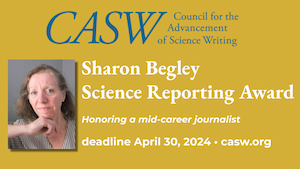H5N1 FLU VIRUS RESEARCH RESUMES, BUT WHAT ABOUT THOSE DEAD FERRETS? Is it really OK that research on the potentially deadly H5N1 bird flu virus is resuming in some parts of the world after a year-long moratorium on flu research imposed voluntarily by scientists doing the work?
Here's some background to what follows: H5N1 is a bird flu virus. Humans appear to be able to get it from birds, and even die of it. But we cannot (yet) pass it on to others. In fact, until recently the virus wasn't transmissible between mammals. But research on ferrets (an animal model for human flu) has shown that the virus can be modified to make it easier to pass on, suggesting that human-to-human transmission could happen and that virulent H5N1 flu might one day sweep around the world.
The voluntary moratorium, imposed on grounds that the research might be potentially dangerous, especially if exploited by bioterrorists, was designed to give governments time to develop safety guidelines. U.S. regulations are still in the works at the National Institute of Allergy and Infectious Diseases, but some countries now have adopted safety measures. Thus a week ago, in the pages of two top-tier journals, Science and Nature, the scientists declared their moratorium at an end.
Paul Raeburn, lead Knight Science Journalism Tracker, complained this week that the news media accounts of this declaration failed to tell him (and the rest of us) what we really need to know.
After casting about most of today, however, I've been unable to find a substantial piece that helps me decide whether this decision to resume research was hasty or whether it makes good scientific sense. I have my doubts about it, but I don't have what I need from the stories I saw or heard to resolve those doubts.
ONLY 24 HOURS TO RESEARCH AND WRITE THE STORY. At least part of the reason the stories were weak may be that the journals gave reporters only 24 hours notice, an unusually short embargo time. Curtis Brainard explains at the Columbia Journalism Review's Observatory. Brainard queried the journals, and the PR people justified the short notice partly on grounds that a longer lead time would increase the chances the embargo would be broken. (For non-journalists in the audience, an embargo break means that some naughty publication(s) would publish the story before the journal wants them to.)
Embargo Watch's Ivan Oransky has greeted that explanation with the snort of derision it deserved. He urges other journals to do what the New England Journal of Medicine does: Share draft versions of papers with reporters. That would give journalists more time to do a better job on complex topics. But I suppose journals might still argue that early release to journalists would encourage those dastardly embargo breaks.
WHAT THE EXPERTS ARE SAYING — AND NOT SAYING. I'm no longer quite as much in love with my top viral guru, Vincent Racaniello, virologist at Columbia, and I'll get to why in a moment. Of course Racaniello had much to say about the lifting of the moratorium. He greeted the news with little glad cries, having opposed the moratorium to begin with. The ferret research, he points out — though few others do — did indeed make the airborne virus leap more easily from ferret to ferret. But he says that in the process the virus was weakened so much that it was no longer deadly. Like Paul Raeburn, Racaniello is also annoyed at journalists, in his case for getting it wrong about how deadly the altered virus is. Racaniello sniffs:
If most of the public obtains their virology information from the popular press, it is no wonder that much of the public distrusts these H5N1 experiments
However, and this is a big however, Debora MacKenzie's new post at New Scientist has given me pause. It describes what's gone on since her reporting on the original talk about the ferret paper at a scientific meeting in September, 2011. She faults the scientists for the spin they have put on the paper, coming not-quite-clean about what the experiment showed.
Turns out that, while some ferrets did inhale the modified virus, 6 had the virus inserted into their windpipes. It was the first group of ferrets — the ones who inhaled — that survived. The windpipe 6 all died 3 days after the experiment. (MacKenzie's piece mentioned the dead ferrets, but not these specific data. I got the numbers from the ferret paper Science published last June. Ferret paper here; I think it's open to all, but possibly not. And while I'm at it, let me point out that the paper doesn't go out of its way to make these data on the deaths obvious; I had to dig around.)
I don't pretend to have read everything about ferrets and H5N1, but MacKenzie's piece was the first I'd heard about the ferret deaths. Even my beloved Vincent Racaniello doesn't mention them in the posts I've cited. So I guess she's right. The researchers have not been entirely forthright.
HURRAY FOR H5N1 RESEARCH? As you would expect, retrovirologist ERV is ecstatic that the moratorium is lifted. He speaks, I suspect, for many scientists when he says
We can study mammal-transmissible influenza now, or we can wait until it evolves in nature, wait until its killing people, wait until its overloading hospital systems, wait until the antivirals are out of supply, and hope we figure out a solution.
Take a look also at ERV's useful explanatory post from last June, which — after a peculiar lede that you can safely skip — is all about the potential for "natural" evolution of H5N1 — and a list of scientists' suggestions for how to keep that from happening. Note, however, that ERV has nothing to say about dead ferrets either.
The World Health Organization has put together recommendations for working with H5N1. WHO suggests that the work be done in labs with biosafety level ratings of 3+ or 4, the highest containment levels. These labs have an encouraging safety record, and I certainly buy the argument that it's better to try to figure out what H5N1 is capable of rather than risk the worst by letting evolution take its course.
But I'd like to feel more confident than I do about practical and effective ways of enforcing the top containment levels. I'd like to be able to wholeheartedly embrace the principle of research freedom. I'd like someone who really knows to explain why the dead ferrets don't matter. And I sure wish scientists hadn't become so adept at spin.
SATURN, ITS MOONS, AND #UPGOERFIVE. Speaking of flu, I complained here a couple weeks ago about a post by Robert Gonzalez at io9 portraying the current winter flu epidemic as super-serious when the data suggest otherwise. The season appears to have peaked earlier than usual, but this is likely to be an average flu year. This, at any rate, is what Racaniello says. I plan to report later in the year about whether my faith in Racaniello's flu forecast is justified.
In the meantime, though, Gonzalez has redeemed himself utterly with his post about #upgoerfive, the challenge to explain complex things using only the 1000 most common English words. The post is crowned by Rachel Klippenstein's upgoerfive description of Saturn and its moons. Not to be missed. Inventive comments, too.
EARLY DISPATCHES FROM #SCIO13. Not all that much blogging from ScienceOnline2013 at N.C. State in Raleigh as I write. But the meeting only began yesterday (Thursday), so there will be more, that I can promise. (Is it possible you've never heard of ScienceOnline? It's the annual meeting devoted to, uh, science online. With a heavy emphasis on blogging and bloggers. For admin details, see below.)
Josh Witten and Michele Banks wisely prepared for their time away from The Finch and the Pea by outsourcing. They preposted their weekly cat photo, Science Caturday (see above), and challenged you to write this week's hilarious caption.
Kelly Oakes of Basic Space took this terrific photo while on her way to SciO13. She then went to a pre-meeting workshop on Rapid Media Prototyping, whatever that is, and posted this timeline of what the two Voyager spacecraft saw on their way outward to the rest of the 'Verse.
Pat Kight live-blogged the #SciO13 session on science communication and social media at Outreach 2.0. One declaration that will annoy many, including me: newspapers and other publications should find scientists and turn them into journalists rather than starting with journalists.
A blogger you will probably not be hearing from at the meeting is NeuroDojo Zen Faulkes, who is arming himself only with analog tools: pen and paper. He's normally a sender of digitalese at meetings, he says, but at #SciO13, there will be 449 other folks doing the same. The point, he says, is to do something different, to take advantage of face time with online friends and colleagues. Very sound, IMO.
Update Wednesday, January 30, 2013. #SCIO13 has just posted a one-stop shopping information page that will help you participate remotely.
The biggest news is that there will be video of sessions available online to all, although only some of it in real time. Those would be the Converge sessions in Room 3, from 9-10 am (Eastern Standard US time, I assume) on Thursday, Friday, and Saturday. They are to be archived soon after broadcasts. The URLs are not yet live as I write so I can't post them here; you'll have to consult the information page.
The moderated sessions in Room 3 are to be broadcast live only to the watch parties described below. But the sessions will be archived and available to all eventually; the information page says in about 3 weeks. The online program doesn't seem to specify which sessions are to be in the videoed Room 3, but maybe that information will be available by the time the videos are public. I'll try to let you know here when that happens. END UPDATE
I can't make it to Raleigh January 30-February 2 for the matchless ScienceOnline fest this year, boo hoo. If you, too, are bereft, take hope, there are virtual opportunities. Not the same as Being There, but.
Find Watch Parties at venues around the globe: North America, Australia, New Zealand, and Europe. There's an official blog to keep you informed about official SciO13 things. Of course there's a Facebook page, and also a Google+ page; these look official too.
Media coverage and blog posts from others about the meeting will be listed here.
There are many concurrent formal sessions, if anything at SciO13 can be called formal. Here's the condensed program; click on the links to get details about sessions scheduled for each time period. Formal sessions are only an hour long, thus confirming suspicions that these are the days of short attention spans.
If an hour is still too long for you, drop in to the Blitz Sessions Friday noon, just 15 minutes each. They're concurrent too.
There's an app for all this: sign up here and sync your selections to your phone or calendar.
There's also, naturally, an official Twitter feed: #scio13. Contributions, however, are not official; anyone can tweet to the #scio13 hashtag, and many do. I, for one. The Twitter feed is probably going to be the best place to find out about live blogging and tweeting from individual sessions, of which there will no doubt be a lot. Expect many declarations that a session or speaker was awesome, and occasionally even <140 characters about what was said.
Expect also many tweets from folks wildly happy to be there and eager to take time out from all the fun they're having so they can brag to you about all the fun they're having. These tweets will help you eat your envious heart out and heap sulky tantrums on those around you.
Let's face it, the schmoozing is the best part, and most of us will miss it. Also, and it breaks my heart to tell you this, the food at the SciO meetings is very good indeed, and quite extraordinary by conference standards. An Unconference indeed.


.png)

